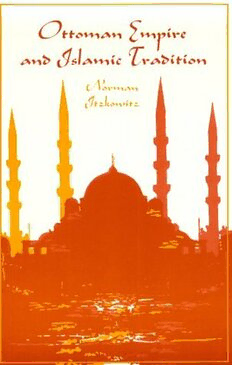
Ottoman Empire and Islamic Tradition PDF
Preview Ottoman Empire and Islamic Tradition
The University of Chicago Press, Chicago 60637 The University of Chicago Press, Ltd., London © 1972 by Norman Itzkowitz All rights reserved. Published 1972 Phoenix edition 1980 ss Printed in the United States of America 83 82 81 5 4 3 2 •'V ISBN: 0-226-38806-9 G) LCN: 79-23386 W ' -V • \ \ ftr xf, cb \ o k cn ? D2l IN LOVING MEMORY OF M innie Kossin Krauss and Jack Itzkowitz BOGAzigi UNiVERSiTESi KUTUPHANESI 0912560 Contents Preface ix Chapter 1 From Emirate to Empire 3 Turkish Migration 4 Seljuks 5 Seljuks of Rum 8 The Emirate of Osman 10 Orhon 11 Ottoman Methods of Conquest 13 Bajazet the Thunderbolt 16 Bajazet’s Legacy 20 Recovery and Renewed Conquest 21 Mohammed the Conqueror 24 Istanbul 27 Bajazet II 29 Selim the Grim 32 Suleiman the Magnificent 34 Chapter 2 Ottoman Society and Institutions 37 Steppe, Ghazi, and Class 38 Askeris and Reaya 40 Timars and Timar-holders 40 Provincial Structure 41 Provincial Administration 47 The Ghulam System 49 The Grand Vizier and the Divan 54 The Bureaucracy 55 Justice 57 The True Ottomans 59 Vll Contents Social Mobility 60 Chapter 3 The Post-Suleimanic Age 63 The Muscovy Menace 63 Conflict in North Africa 65 Conflict in the East 68 Conflict in the West 71 Back to the East 72 Ottoman Succession 74 Sultanate of the Women 75 The Kuprili Era 77 Second Siege of Vienna 81 Aftermath of 1683 82 Chapter 4 Ottoman Consciousness 87 The Circle of Equity 88 Disruption in the Timar System 89 Expansion of the Janissary Corps 90 Sekbans and Celdlis 92 Causes 93 The Kuprili Era in Perspective 99 The Historian Naima 100 The Medical Analogy 101 Eighteenth-Century Success 103 Ottoman Knowledge of Europe 104 Success Breeds Failure 107 The Ottoman-Russian War 108 Selim III 108 Bibliography 111 Chronology 115 Glossary 117 Index follows page 118 viii Preface This book provides the student with an introduction to the historical development of the Ottoman Empire and an appreciation of its institutions, social structure, and intel lectual foundations. The narrative carries the Ottomans from their beginning on the Byzantine frontier as an Islamic warrior principality, through the development of their empire, down to the late eighteenth century when they found it necessary to embark upon the process of moderni zation. I have delineated the fundamental institutions of the Ottoman state, the major dividing lines within the society, and the basic ideas on government and social struc ture that helped the Ottomans found their empire, fostered its growth, and then sustained it through periods of inter nal dissension and external threat. Patterning the fabric of Ottoman existence in all its manifestations was the High Islamic tradition in govern ment and society. That tradition had been mediated to the Ottomans through the Seljuks of Rum who had preceded them in Anatolia. Entailing orthodoxy in religious matters, fiscal policies characterized by their differential treatment of Muslims and non-Muslims, a military establishment supported largely by feudal grants, an administrative- military elite of slaves trained in the service of the sultan, and a class structure that divided society into legally privileged and non-privileged, the High Islamic tradition provided the modality through which the Ottomans expe rienced the world and interacted with it. Latecomers as the Ottomans were in the chronology of Islam, there was still room for them to contribute to the inherited tradition and mold it with their own particular genius for administration and government. Their innova tions and refinements include the levy of young male Christian subjects for the slave household and military establishment, the palace school with its system of promo IX Preface tions and interlocking relationship with the administration of the external real world through the graduation process, and the elaboration of the social structure along functional lines. The emphasis in this work is on how the Ottomans viewed their historical experience, what they thought about their society, how they conceptualized their problems, and their own attempts at problem-solving. I have sought to let the Ottomans speak for themselves. In this way we can penetrate beyond the surface view provided by the insights of Western observers of the Ottoman world to the core of Ottoman existence. I have had to be selective in the events described and topics treated, for it is manifestly impossible to cover five hundred years of history fully within the confines of so short a book. The stress is on the sweep and grandeur of Ottoman history just to the point when the impact of the West would begin to be felt in the Near East. I hope this work will provide insights into how another culture dealt with the problems of government and society, as well as with those of greatness and decline. In the course of writing this book, I have drawn upon the research of many of my colleagues in the field. I wish to thank them all, and to acknowledge a special debt to the work of Claude Cahen, Halil Inalcik, Bernard Lewis, Geoffrey L. Lewis, Victor Menage, Lewis V. Thomas, Dorothy Vaughan, and Paul Wittek. I am indebted to them for the insights they provided and for the inspiration of their example. The act of synthesizing my own views with the body of accumulated wisdom proved to be a most enjoyable experience. I am most grateful to Geoffrey L. Lewis who read the manuscript and made valuable sug gestions, and to John W. Shy for his encouragement. N. I. Princeton, New Jersey March, 1972 Ottoman Empire and Islamic Tradition
